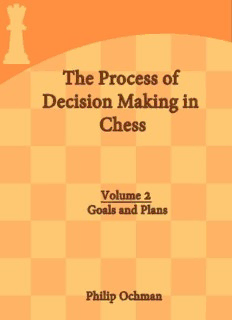
The Process of Decision Making in Chess: Volume 2 PDF
Preview The Process of Decision Making in Chess: Volume 2
All rights reserved. No part of this book may be reproduced or transmitted in any form or by any means without written permission from the author, except for the inclusion of brief quotations in a review. Copyright © 2014 by Philip Ochman. First Edition, 2014 ISBN: 9781483538822 In the memory of my grandfather Shulem Keilis (1924-2001), forever a soldier and a true fighter for what is right, my first ever “chess student”, for teaching me that a teacher has a lot to learn from every one of his students. Contents Foreword Acknowledgements and contact info Process application chart Introducing the practical application – a motivational example From the full process to shorter ones Observation Tactical observation The nature of a position The “Critical Squares” method Classification of tactical opportunities Threats analysis Our tactical resources The initiative Positional observation Survey of the positional criteria Survey of the pawn structure Types of structure Pawn structure weaknesses Endgame planning Square weaknesses Main illustration examples – observation stage: Beginner: Opening | Middlegame | Endgame Intermediate: Opening | Middlegame | Endgame Advanced: Opening | Middlegame | Endgame Expert: Opening | Middlegame | Endgame Identification of goals Defensive goals Offensive goals Main illustration examples – goals stage: Beginner: Opening | Middlegame | Endgame Intermediate: Opening | Middlegame | Endgame Advanced: Opening | Middlegame | Endgame Expert: Opening | Middlegame | Endgame Plans Meeting the goals Setting the priorities The concrete solution The final design Move order “Plan B” Safety check Main illustration examples – plans stage: Beginner: Opening | Middlegame | Endgame Intermediate: Opening | Middlegame | Endgame Advanced: Opening | Middlegame | Endgame Expert: Opening | Middlegame | Endgame Congratulations! Appendix 1 – Learning work-pages Appendix 2 – Application work-pages Appendix 3 – Meet the players Appendix 4 – FEN’s of the main diagrams My dearest student, This book was written especially for you, the improving chess player, to learn how to successfully apply the theory of decision making in chess. Together, we will study new ideas of how to approach a position, how to understand what we are playing for, and how to identify and achieve all of the goals arising from our observation. We will reinforce concepts learned from the first volume of the series, concentrating on their practical application. The practical thinking process described in this book will have the following structure: Having already built your theoretical understanding of the chess concepts, we will now take them one step further and learn how this new knowledge, combined with additional ideas, can help us find the best plans, not only the best moves, in every position. For students who are new to the process of decision making in chess, this book will offer new insights and a full scale revolution to the whole thinking process in chess, making it much more effective and efficient. Having read this book, your ability to make decisions -- even in the toughest of chess positions -- will rise to new heights, and finding your way in a maze of strategies and tactics will become your second intuitive nature. Philip Ochman, Sep 2014 Acknowledgement I would like to use this opportunity to thank my dear friend and student Mr. Michael Shpizner for his great help and contribution in making this book readable. This book wouldn’t exist without your help. A huge thank you goes to the readers of Volume 1 – your emails and feedback made my day each time, and I’m very happy to stay in touch with you! You make me feel like a useful person. To my students- thank you for helping me shape this teaching method by your comments and feedback in our lessons. You are the reason I originally decided to put what worked in the lessons into writing, and you deserve all the credit for making it possible! Contact information You are always welcome to contact me by email: [email protected] or [email protected] , by message on my website (StrongerChess.com), or via Skype (find me: philip.ochman).
Description: